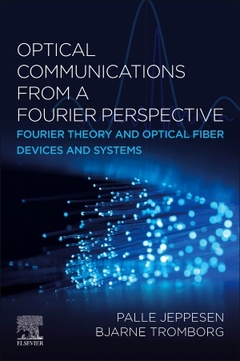Optical Communications from a Fourier Perspective Fourier Theory and Optical Fiber Devices and Systems
Auteurs : Jeppesen Palle, Tromborg Bjarne

Optical Communications from a Fourier Perspective: Fourier Theory and Optical Fiber Devices and Systems covers Fourier theory and signal analysis over photonic components, including time lenses in optical communication. Sections cover wave propagation in optical waveguides based on Maxwell equations and the nonlinear Schrödinger equation. Optical Fourier transform in the form of time lens is covered, for example in modulation format conversion and spectrum magnification, and couplers and their use for optical discrete Fourier transformation are also discussed. Other important subjects are discussed such as shot noise, thermal noise and also the basics of four wave mixing in relation to time lenses. Detailed derivations and a deeper background for the chapters are provided in appendices where appropriate. Some of the theory is more generally applicable beyond optical communication and is of relevance also for communications engineering. The Fourier theory dimension of the book presents the relationship between Fourier series and Fourier integrals and also the related Laplace transform.
2. Fourier series, Parseval's theorem, FFT and Cooley-Tukey algorithm
3. Fourier integrals and Fourier series
4. Properties of the Fourier transform and Heaviside's step function
5. Complex signal, complex envelope and Hilbert transform
6. Correlation functions, spectral density, Wiener-Khinchine theorem
7. Linear, time-invariant systems
8. Transfer matrices and frequency filters
9. Laplace transforms, transfer functions, Nyquist criterion
10. Maxwell's equations, optical waveguides and Poynting's vector
11. Pulse propagation in optical fibers
12. Split step Fourier method and nonlinear Schrodinger equation
13. Introduction to modulation formats
14. Required bandwidth for heterodyne and homodyne detection
15. Bandpass noise
16. Bit error rate
17. Pulse shaping using optical Fourier transform
18. Spectrum magnification
19. Optical Fourier transformation, dispersion compensation, jitter suppression
20. Regeneration of WDM phase-modulated signals
21. Time-space duality, dispersion and diffraction, time lens
22. Couplers and their use for optical DFT
23. Multicarrier modulation, OFDM, DFT, Nyquist modulation
24. Optical orthogonal frequency division modulation
Palle Jeppesen is professor emeritus at the Technical University of Denmark (DTU) and a researcher with many years’ experiences in optical fiber communications, lasers, fibers, systems, and ultra-high-speed optical communications. He has been a member of the Danish Technical Research Council, the Scientific Council for the Danish National Encyclopedia, and on the boards of a number of large corporate entities. His current research interests are optical signal processing, optical multi-level modulation formats, and terabit optical communication.
Bjarne Tromborg was formerly a research and teaching professor at the Technical University of Denmark (DTU) best known for his work in particle physics and photonics. He has been a member of the Danish Natural Science Research Council and many technical program committees. He has published widely on the topics of optoelectronics, semiconductor lasers, and optical communications
- Introduces Fourier theory and signal analysis tailored to applications in optical communications devices and systems
- Provides a strong theoretical background and a ready resource for researchers and advanced students in optical communication and optical signal processing
- Starts from basic theory and then develops descriptions of useful applications
Date de parution : 11-2023
Ouvrage de 506 p.
15.2x22.8 cm



